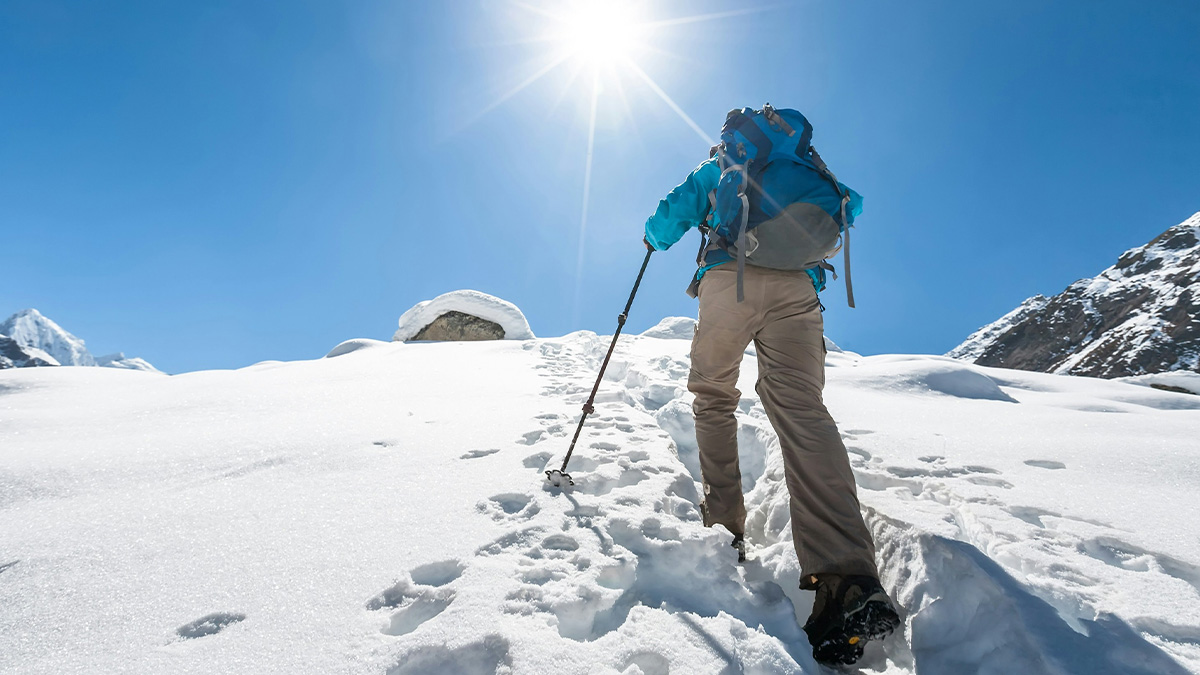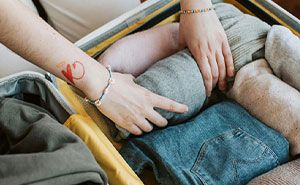Despite the fact that really anyone would agree that first aid is a valuable skill, the reality is that less than half of the population has any experience with it. While a list of facts from the internet is hardly a replacement, it can still be a good idea to at least cover some simple ideas that could actually help someone in need.
We’ve gathered some examples of tips, tricks and just facts that could be life-saving in the right circumstances. So get comfortable as you scroll through, upvote your favorite examples and be sure to share your own stories and ideas in the comment section below.
This post may include affiliate links.
 Not me but a friend.
Not me but a friend.
We decended in a parachute drop. I landed first and when I looked for him he was coming down hard and fast with his chute only partly open. Then right at the last minute he popped his reserve. No sooner did the reserve pop open than he touched down, hard but unharmed.
We were all gushing over how brave and lucky he was until he told us he had heard the instructor on the ground screaming at him
“deploy your reserve you bloody idiot”
 I can tell you about the advice which saved my life.
I can tell you about the advice which saved my life.
It happened during my business trip to Mauritius. That was the first time that I was going to see the Indian Ocean so I was very excited about the prospect. When we arrived, the very first thing I wanted to do was to put my swimming suit on and take a swim from the hotel beach. I did so. I swam a couple of hundred meters and decided to return. I started moving towards the hotel beach. But it did not work out. I tried different methods but each time waves drove me more and more away from the beach. “That might be a silly ending”, I thought. And that was the point when I recalled what my swimming instructor told me once about swimming in open waters. He said, “Never try to fight waters, by doing so you will get tired very quickly and spend your energy with zero result. Your task is to relax, to feel dynamics of the waves and move in line with them. Imagine you’re a part of it”. I guess it was only the 7th try when I managed to catch a wave and finally swam back to hotel.
His casual advice saved my life. I can’t know if it will save yours but you can never know.
Just remember: Swim parallel to the shore to escape a rip tide.
 Lives are saved in the first 5 minutes of an emergency. Those first 5 minutes, before an ambulance arrives in most of the developed world, quite literally can be the difference between life and death.
Lives are saved in the first 5 minutes of an emergency. Those first 5 minutes, before an ambulance arrives in most of the developed world, quite literally can be the difference between life and death.
The three things to note are what we refer to as the ABC’s
Airway (clear and open, not in anaphylaxis, etc)
Breathing (Just if they are breathing relatively adequately. Even a collapsed lung can be delayed for treatment up to 10 minutes)
Circulation (heart pumping, no matter rate or blood pressure, not losing a lot of blood from a veinous or arterial bleed)
If the person doesn’t have an open airway it can be from a few things that are usually easily rectified
Choking on food.
Perform abdominal thrusts if the person is conscious and standing (previously known as the Heimlich Maneuver)
If they are laying down or unconscious, perform chest compressions like in CPR, with the hands directly between the n****e line, pressing down a few inches in an adult
Choking on tongue.
If there is no indication of spinal trauma, perform a head tilt chin lift by placing the palm of one hand on the person’s forehead and lifting up and back on the mandible (jaw) at the chin.
If there is indication of spinal trauma, perform a jaw thrust maneuver by positioning yourself above the head (when they’re laying down), placing your hands on their cheeks, and lifting the jaw up and forward with your fingers, while making sure not to move the neck at all
If the person isn’t breathing, it can be due to a few things
Narcotic/o****d overdose
Administer narcan
Other respiratory depression
Begin artificial respirations with a barrier device
If the person doesn’t have a beating heart
Regardless of cause, begin chest compressions and ventilations if applicable
If the person is bleeding out
start with direct pressure
If that doesn’t work, use a pressure dressing
If that doesn’t work, on a limb, use a tourniquet (NEVER USE A TK ON A NECK)
On the abdomen, pack the wound (put gauze into it) and call for immediate transport
With this basic knowledge and a CPR class, you can be prepared to save lives in your home, office, and social events.
I think that everyone should be trained to at least this level by any job on an annual basis, as well as in high school, because trained bystanders quite literally have and will continue to save countless lives because of it.
The breathing part of CPR is negligible in a situation with lay people. There's already a good amount of oxygen in the bloodstream, just do compressions. More important to do compressions vigorously than fumble with breaths. Open the airway and make sure air can move but focus on compressions unless you do it regularly, and have someone to switch out with.
 In case, you find yourself trapped in snow and you are dehydrating at much faster rate with no water in your bottle.....
In case, you find yourself trapped in snow and you are dehydrating at much faster rate with no water in your bottle.....
Do Not Ever Consume Snow.
Albeit, it makes sense for one to think that snow contains water and it might save you from dying, but you're wrong. Your body is already losing energy. A body can digest snow only after its system first converts it in liquid. With limited energy in body, you don't want burn your calories to convert liquid from snow.
What to do?
Fill your bottle with snow and place it inside your jacket. Do not make contact with skin by thinking it'll melt snow faster. Fundamental law of thermodynamics will take place; heat will flow from hot to cold body. Thus, you'll start draining your energy. Maintain a layer or two between pocket and skin.
Also, you should try to think ahead of time by filling bottle with snow when its about half or less. Kind of preemptive strike.
Hope someone will rescue soon. Staying calm and positive are equally crucial.
 Not my life, but it helped me save my dad's.
Not my life, but it helped me save my dad's.
We were canoeing in Georgia and our canoe got hung up on a cypress knee. As I was trying to backstroke our way off it, my parents (Mom in front, Dad in the center) were talking to a guy who wanted to help. He handed my mom a rope and their plan was to yank us free. I looked up just a moment before he revved his boat's engine. I yelled, “Nooo… glug glug glug” because obviously you should NEVER yank a canoe!!
We all fell into the drink. I remember hitting the spongy bottom and pushing back up. I surfaced with my glasses still on. My mom did, too. A split second later, she started screaming for my dad. He hadn't come up.
Into my head popped a boating safety article I had read in Redbook magazine at least ten years earlier: if your boat capsizes, and someone is missing, look under the overturned boat.
I calmly reached under, found a skinny elbow, and pulled him down and out. He was wearing shoes or something that floated, which was making it hard for him to keep upright. In the frigid water, disoriented and going into shock, he didn't think to get out from under, instead he was trying to get that little pocket of air between the water and the canoe, and he wasn’t able to.
My mom later asked me how I thought of that. It just came to me, a little bit of trivia I never would have imagined using.
I'm so glad I react to stress by slowing down to a zen-like calm!
 General first Aid Tips
General first Aid Tips
Firsf of all we need to build a First Aid Kit and keep it handy..
How do I make a first aid kit?
A well-stocked first aid kit is a must-have for treating minor injuries at home and on the go. Keep your supplies in a sturdy, clear plastic box so you can see what’s inside.
What should be in the first aid kit?
Adhesive tape
Alcohol wipes
Allergy medicine
Aloe vera gel
Antibiotic ointment
Bandages in different sizes
Calamine lotion
Cold packs
Elastic bandages
Gauze rolls and pads
Hand sanitizer (for your travel first aid kit)
Hydrocortisone cream
Latex-free gloves
Pain relievers like paracetamol ibuprofen
Saline wound wash
Scissors and tweexers
Where should first aid kit be stored?
First aid kit should be easy to find in case of emergency. But it should be kept in a high, childproof cabinet, far away from kids’ prying fingers. Keep one full-sized kit in a central spot at home, such as your kitchen or bathroom. Then put a smaller kit in your car or purse for when you’re on the road.
How often should it be checked?
Items can run out if you use them often, and medicines can expire if you rarely need them, so go through everything in your kit, and replace any empty or out-of-date items at least once in 6 months
Management part..
Cuts and Scrapes
How to treat a minor cut or scrapes?
1. First, wash up with soap and water so you don’t get bacteria into the cut and cause an infection. If you’re on the go, use hand sanitizer.
2. Stop the bleeding. Put pressure on the cut for few minutes with a gauze pad or clean cloth.
3.Clean the wound.
Remove any dirt or debris. Use a pair of tweezers cleaned with alcohol to gently pick out any dirt, gravel, glass, or other material in the wound.
Do I need to bandage a cut or scrape?
You don’t need to bandage every cut and scrape. Some heal more quickly when left uncovered to stay dry. But if the cut is on a part of the body that might get dirty or rub against clothes, put on a bandage to protect it. Change the bandage every day or whenever it gets wet or dirty.
How long should a cut or scrape be covered?
Once a solid scab has formed, you can take off the bandage.
When do I need to call my doctor?
1. When the cut is deep, long, or the edges are jagged. You may need stitches also if the cut or scrape is from a dirty or rusty object. You may need a tetanus shot.
2. When the injury is from an animal or human bite.
3. You can’t stop the bleeding with direct pressure.
4. You can’t get dirt out of the wound.
The cut is on your face or near a joint, like on your fingers.
5. The skin around the cut gets red and swollen or develops red streaks.
6. Pus drains from the cut.
7. You have a fever of more than 100.4 F
How do topical antibiotic ointments work?
Topical antibiotics are medicines put on the skin to k**l bacteria. Although most cuts and wounds heal without ointment. If you do use an antibiotic ointment, apply it to your skin one to three times a day and then cover with a clean bandage.
Nosebleeds
How do I treat a nosebleed?
Nosebleeds usually look a lot worse than they are. Most of the time you can stop the flow with a few simple steps:
1. Lean the head slightly forward, so blood doesn’t run down the throat.
2. With a tissue or washcloth, gently press the nostrils together to stop the bleeding.
3. Hold the nose for at least 5 minutes. Then check to see if the bleeding has stopped. If it hasn’t stopped, gently squeeze for another 10 minutes.
Go to the doctor if:
1. The bleeding hasn’t stopped after 15 to 20 minutes or keeps starting again.
2. The bleeding is fast and there’s a lot of blood.
3. The bleeding is from an injury to your nose or face.
4. You feel fainting or weak.
Movies/series show **the exact opposite** for nosebleeds so you can still see the actor's face but it is 100% irresponsible to make so many people think tilting *back* is the way to go. It is not.
 Splinters
Splinters
How do I remove a splinter?
splinter is a fragment of a larger object, or a foreign body that penetrates or is purposely injected into a body. It may be a glass piece or a wooden piece.
If the splinter is sticking out of the skin:
1. Wash the skin around the splinter with soap and water.
3. Clean a pair of tweezers with a cotton swab dipped in alcohol.
4. Grab the end of the splinter with the tweezers.
5. Pull it out at the same angle as the splinter went in.
6. Clean the skin again with soap and water.
If the splinter is under the skin:
1. Wash the skin around the splinter with soap and water.
2. Clean a needle and tweezers with alcohol.
3. Gently scrape away the skin above the splinter with the needle until you can see the top of the splinter.
4. Grab the end of the splinter with the tweezers and pull it out at the same angle it went in.
5. Clean the skin again with soap and water.
Animal Bites and Insect Stings
How do I treat animal bites and cuts
1. Hold a towel or gauze to the area to stop the bleeding.
2. Clean the wound with soap and water.
3. Cover it with a clean bandage or gauze pad.
When should I see a doctor for an animal bite?
1. For any animal bite, you may need an antibiotic to prevent infection.
2. If the bite was caused by an animal you don’t know, or by any wild animal like a raccoon, skunk, or bat. You may need a tetanus or rabies vaccine.
3. The bite is large, or it doesn’t stop bleeding after you’ve held pressure on it for 15 minutes. It may need to be closed with stitches.
4. If bite may have damaged a bone, tendons, or nerves, because you can’t bend or straighten the body part or you’ve lost feeling in it.
5. The wound is red, swollen, or oozing fluid.
How do I treat bee, wasp, and other insect stings?
1. If the insect has left behind a sting, remove it from the skin so less of the venom gets into your body. Don’t squeeze the stinger. You might release more of the venom into your skin.
2. Once the stinger is out or if there is no stinger, wash the area around the sting with soap and water.
3. Hold an ice pack or cool washcloth to the sting to stop it from swelling.
4. Spread calamine lotion or baking soda mixed with water to relieve pain.
5. To prevent itching, use a spray or cream containing hydrocortisone or antihistamine.
How do I treat a mosquito bite?
1. Apply firm pressure to the bite for 10 seconds to help stop the itch.
2. Use a hydrocortisone cream 4 times a day to relieve itching.
3. Take an antihistamine if the bite is very itchy.
How to know if the insect bite has caused allergy to the body?
1. Dizziness
2. Hives -- red, itchy bumps on the skin
3. Stomach cramps, vomiting, or diarrhea
4. Swelling of the tongue
5. Trouble breathing, wheezing
Go to the doctor promptly to ward off chances of anaphylactic shoc.
sandpaper, about 120-180 grit, is excellent for removing metal splinters. just use against the insertion direction only
 Well, all of the answers here are about life saving techniques for Homa-Sapiens, but we also have other living beings on this planet. This technique is meant for plants.
Well, all of the answers here are about life saving techniques for Homa-Sapiens, but we also have other living beings on this planet. This technique is meant for plants.
Whenever I go for any trip which is longer than 2–3 days and have no one to water my plants, I insert water-filled bottles with their open end inside soil. Soil sucks the water gradually according to its need (pressure built by roots) and plants can survive for 1 week.
If you are wondering that why there are pens inserted into pots, then yes that is another life saving hack for plants to keep them safe from “nosy Pigeons”
 The moment my father yelled “Duck!” saved my life.
The moment my father yelled “Duck!” saved my life.
I was 16. It was a quiet Saturday morning. My father was teaching me to drive on the interstate for the first time. We took the brand new Dodge Colt E that he had bought me onto I-40 Eastbound in downtown Knoxville, Tennessee. Suddenly, he yelled “Duck!” and I thankfully did.
At that moment, a tractor trailer that had been on the opposite side of the interstate and crossed the median slammed into our car. The truck driver had fallen asleep. The impact took off the roof of the car, chopped off my headrest, and removed the back half of the car. Without ducking, I would have been decapitated.
It was a good two months before I had the nerve to drive a car again. Thank you, Dad, for saving my life. He’s in heaven now.
 Minor Burns
Minor Burns
What are the different types of burns?
Grabbing a hot pot or splashing boiling water on your skin are just two common causes of burns around the house. When you get a burn, first check to see which type it is. Some are more serious than others.
First-degree burns are painful but minor. They turn red and may swell.
Second-degree burns form blisters. The skin may be very red and painful.
Third-degree burns make the skin look white or charred. The burns may not hurt because nerves have been damaged.
When should I see a doctor?
1. You have a third-degree burn.
2. The burn is larger than 2 to 3 inches.
3. The burn is on your face, hands, feet, or over a joint like your shoulder or knee.
4. The burn goes all the way around a hand, arm, foot, or leg.
5. The pain gets worse instead of better.
6. The burn was caused by electricity or a chemical.
7. fluid or pus oozing from the burn.
How do I treat burns?
For first-degree burns and small second-degree burns at home
1. Place the burned area under running cool water for at least 5 minutes to reduce swelling.
2. Apply an antiseptic spray, antibiotic ointment, or aloe vera cream to soothe the area.
3. Loosely wrap a gauze bandage around the burn.
4. To relieve pain, take paracetamol ibuprofen
5. Never put butter on a burn or pop any blisters that form. You could damage the skin and cause an infection.
For a serious third degree burn go to a doctor
Sunburn
How do I treat a sunburn?
1. Always wear sunscreen when you’re outdoors to protect your skin from the sun. If you stay outside for too long without protection, you can get a red, itchy burn that may blister. As soon as you spot a sunburn, head inside to treat it.
2. Soothe your burned skin with a cool, damp washcloth. Or take a cool shower or bath. Pat your skin dry afterward. Be gentle -- your sunburn may be sore.
3. Apply an aloe vera lotion. Or use a hydrocortisone cream to relieve the itch.
4. Do not use lotions that contain petroleum, benzocaine, or lidocaine. These ingredients can irritate the skin even more.
5. A sunburn can dry out your body. Drink extra water so you won’t get dehydrated.
6. Cover your burned skin with clothing and a hat to protect it when you go outside.
See a doctor if you have blisters on the sunburn, or you get a fever or chills. Don’t pop the blisters. They could get infected.
P****n Ivy and Other Poisonous Plants
How do I treat a rash from p****n ivy or other poisonous plants?
When you touch p****n ivy or p****n oak or sumac the rash that appears on your skin is caused by an oil in the plant. The rash may itch and blister. But it should go away on its own within a few weeks.
Treat the rash and itch at home with these steps:
1. Wash your skin. To get as much of the oil off as possible, clean your skin with soap and lukewarm water.
2. Wash everything. Clean anything the plant touched -- your clothes, gardening tools, even your pet. The oil can stick to these objects and cause a rash if you touch them again.
3. Apply calamine or hydrocortisone cream. These products will also relieve the itch.
4. you should take an antihistamine or steroid medicine by mouth.
5. Don’t scratch! Though the rash might itch, resist the urge to scratch or pick at the blisters.
When should I get medical help for p****n ivy, oak, or sumac?
Go to the doctor if you have developed allergic symptoms.
1. Trouble breathing or swallowing
2. Rashes or blisters on a large part of your body, or on your face or genitals
3. Swelling, especially of the eyes
4. An itch you can’t relieve, no matter what medicine or lotion you use
5. A fever over 100 F
6. A rash that hasn’t gone away after a few weeks
 I was seventeen and my friends and I went to Mexico to party. My friends and I got separated in a club because of this huge fight and the police escorted a lot of people outside including me. My friends were still in the club and didn’t know I was outside (this was before cell phones) and I had given my friend my ID and wallet. I ended up hitchhiking back across the border to a gas station (it’s now 3:00 am). I still need to get home because no one is answering their answering machine (yes machines!) so I hitchhike with a trucker heading to LA (ugh!). We’re heading down the freeway and things get out of hand fast. Years before I’d seen in a movie where a girl pretended she was going to be sick and puke when a man was coming on to her so that’s what I did and FAST! He didn’t buy it at first but eventually pulled into a gas station. I walked in normally so the man wouldn't think I was trying to get away and told the attendant this man was keeping me against my will and he hid me in a counter. The driver came in looking for me and I could hear the gas station attendant saying “no, there’s no on one here.” After a long while he left. 911 was called and the police gave me a ride home (it was an hour ride) and the whole way home they asked “are you ever going to do this again??”. They insisted on speaking to a parent but little did I know that my little sister had seen the police car pull up, had put a sheet around her head and pretended to be my mom while talking to the police. What a cool sis! Yeah-the 80’s were a different time but I did learn my lesson.
I was seventeen and my friends and I went to Mexico to party. My friends and I got separated in a club because of this huge fight and the police escorted a lot of people outside including me. My friends were still in the club and didn’t know I was outside (this was before cell phones) and I had given my friend my ID and wallet. I ended up hitchhiking back across the border to a gas station (it’s now 3:00 am). I still need to get home because no one is answering their answering machine (yes machines!) so I hitchhike with a trucker heading to LA (ugh!). We’re heading down the freeway and things get out of hand fast. Years before I’d seen in a movie where a girl pretended she was going to be sick and puke when a man was coming on to her so that’s what I did and FAST! He didn’t buy it at first but eventually pulled into a gas station. I walked in normally so the man wouldn't think I was trying to get away and told the attendant this man was keeping me against my will and he hid me in a counter. The driver came in looking for me and I could hear the gas station attendant saying “no, there’s no on one here.” After a long while he left. 911 was called and the police gave me a ride home (it was an hour ride) and the whole way home they asked “are you ever going to do this again??”. They insisted on speaking to a parent but little did I know that my little sister had seen the police car pull up, had put a sheet around her head and pretended to be my mom while talking to the police. What a cool sis! Yeah-the 80’s were a different time but I did learn my lesson.
 IF by Rudyard Kipling — If you can keep your head when all about you are losing theirs.
IF by Rudyard Kipling — If you can keep your head when all about you are losing theirs.
There is NO greater skill in an emergency than being able to keep a clear head and preventing the panic from taking hold. None.
One technique that was taught to me was mentally adjusting your beret. What that means is that when you see everything in front of you turn to a big pile of c**p you stop and take a big deep breath. Imagine adjusting a beret that's on your head.
This has saved my backside on countless occasions. When my brain and body initially scream RUUUUUUN and AAAAAAAARRRGGGGHHH. Taking just those few extra seconds to catch your breath will allow you to make sense and can allow you to make quick crucial decisions.
 In a nuclear explosion, most of the damage and death is caused by the shockwave the blast creates, not the fireball which has a comparatively small radius.
In a nuclear explosion, most of the damage and death is caused by the shockwave the blast creates, not the fireball which has a comparatively small radius.
One day you may find yourself outside or looking out a window to see an extremely bright flash. As bright as if you were staring straight at the sun. Do not attempt to locate the source of the flash. You have maybe 8-10 seconds to respond if you're far enough away from the fireball.
Lay face down on the ground and put your thumbs in your ears and fingers over your eyes. Breathe through your teeth. Since you're laying face down the shockwave will mostly pass over you. (If you're standing up it can cause your lungs, eardrums, and other organs to explode.)
Once the shockwave passes over you, you need to find shelter immediately. I said before that most death from the explosion is caused by the shockwave.
Well, FAR more death is subsequently caused by nuclear fallout AFTER the blast. Do not attempt to travel anywhere.
Just get underground. If you're next to a complete stranger's house or a business, don't hesitate to go inside and hide out under as much concrete and steel as possible.
You need to remain in this location for the next 48 hours. This is critical. Even if you survive the blast if you attempt to go home and spend just 20 minutes outside traveling you will more than likely die of radiation sickness.
Radioactive material after a blast decays exponentially, and you will be safe to try and find your loved ones after 48 hours. If you don't wait this out, you definitely won't be alive to find them.
 “You’re always sick when I call. You should see a doctor”. This was from my wife’s grandmother. Nonsense was what I thought; as a guy, my mental image of myself is that I’m always healthy and don’t need to see a doctor.
“You’re always sick when I call. You should see a doctor”. This was from my wife’s grandmother. Nonsense was what I thought; as a guy, my mental image of myself is that I’m always healthy and don’t need to see a doctor.
Turns out, there’s an adult-onset immune thing, pretty rare, so that slowly your immune system stop making immune globulins and therefore I was always getting colds. And, in retrospect, always had a fever, and always had congested lungs, and always had inflamed sinuses. And, as it turned out, some of those colds were actually pneumonia.
Luckily, there’s a treatment, and now I can breathe through my nose again, and wake up in the morning and not spit up phlegm. And I’m likely to live beyond 42 (the actual average age of death for this condition).
(If you think you’re always sick, and you might have this, rest assured, you almost certainly don’t. It's rare enough that there’s only one clinic in Seattle that handles it, and they take in patients from several of the surrounding states).
 I once heard that people who fall in the water sometimes drown while wearing a life jacket. They get disoriented and try to swim to the surface, but instead swim downward. (I don’t know if this is actually true, but it’s true that I heard that.)
I once heard that people who fall in the water sometimes drown while wearing a life jacket. They get disoriented and try to swim to the surface, but instead swim downward. (I don’t know if this is actually true, but it’s true that I heard that.)
Then it happened to me.
I was riding a waverunner and went over a wave and unexpectedly nosed the waverunner into the face of the next wave. I was ripped from the seat, and my first thought while underwater was, relax, let the lifejacket bring you to the surface.
Had I not heard that tidbit of information, I could have had a really bad day. As it was, the incident left me stiff and sore, with a concussion from hitting the water at high speed.
Something I read and haven’t had to put to the test, is if you don’t know which way up you are, breathe out some air bubbles and watch which direction they go in. That direction is up so follow the bubbles.
 There are many skills which can help in any kind of emergency. First and foremost call the paramedics and inform them your complete location and address. CPR is the crucial think one should know. Other then this, any kind of emergencies like breathing problem, and choking.
There are many skills which can help in any kind of emergency. First and foremost call the paramedics and inform them your complete location and address. CPR is the crucial think one should know. Other then this, any kind of emergencies like breathing problem, and choking.
Injuries are worsen in workplaces while waiting for a doctor or paramedic to arrive. With basic first aid training like wound the bandage on the wound or stop bleeding from a cut which sometimes cause a person to faint.
 1. Stop bleeding by applying direct pressure on the wound. Open wounds and cuts can result in serious blood loss and can be life threatening.
1. Stop bleeding by applying direct pressure on the wound. Open wounds and cuts can result in serious blood loss and can be life threatening.
2. Protect broken bones until the professionals arrive. Broken bokes can be very dangerous, especially in your back or close to an artery.
3. Good hydration will prevent heat stroke. Make sure you have enough fluid with you on your adventure so that you can regularly hydrate.
4. Learn and practice the Heimlich Maneuver - you can prevent someone from choking to death on a piece of food.
First aid is a necessary skill which I believe everyone should know. More and more people are venturing outdoors and partaking in extreme sports. It is especially important for them to have done first aid training. Extreme sports include abseiling, trail running, river rafting, mountain biking, sky diving, bungy jumping, etc. Any sport that gets the adrenaline rushing through your veins at a fast rate is considered an extreme sport. Knowing how to care for a wound until the emergency services arrive can be the difference between life and, in extreme cases, death.
You will be in good stead when you empower yourself with an accredited first aid course.
 If you choke on food while there's no one else around to help, you can dislodge it by making yourself fall on a hard edge, like the edge of a table or the upper edge of a chair back. Make sure it hits you right below the ribs. This imitates the effect of the Heimlich maneuver.
If you choke on food while there's no one else around to help, you can dislodge it by making yourself fall on a hard edge, like the edge of a table or the upper edge of a chair back. Make sure it hits you right below the ribs. This imitates the effect of the Heimlich maneuver.
 Not mine, but possibly a few men and women’s in the lab across the hall.
Not mine, but possibly a few men and women’s in the lab across the hall.
I heard the description of phosgene during military training while in college. I have never been exposed to it and had no idea how accurate the description was, or whether it was even feasible to describe a smell verbally.
One of my colleagues was a smoker. A woman in the lab next door regularly popped in, dragging him out into the stairwell to serve as a smoking companion. One day, she opened our door, popped her head in and began her routine smoking call, addressing my lab mate. She abruptly paused in the middle of a word, fainted and fell on the floor while grasping at the door handle. The door swung fully open and let in a whiff of rotten hay.
It took me a few seconds to connect the goings-on and the description of phosgene I heard in college. I commanded everyone nearby to open the windows and stick their heads out, called the institute’s fire crew, opened the door to the lab across the hall and noticed thin white smoke emanating from the sink area.
After the building was evacuated and all rooms aired, it turned out that the woman who fainted mid-sentence had been running a protein purification job, dumping her waste fractions and spent reagents into the sink. Simultaneously, someone in the lab on the upper floor was busy cleaning glassware with a corrosive concoction of potassium dichromate and acids, dumping it into the same drain. It reacted with the products of the protein job, producing phosgene, among other things. The cast iron drain pipe had long been corroded through. It let the gaseous products into the room. It didn’t help that the smokers in both labs couldn’t smell anything until it was almost too late.
The hazmat guy on the fire team had a phosgene indicator badge. He confirmed that phosgene was the main trouble-maker, and it was also consistent with the condition of those affected. Everyone survived, and I learnt that the rotten hay analogy was spot-on.
 When I was a child and young adult I had keen interest in water sports.
When I was a child and young adult I had keen interest in water sports.
Almost drowned three times.
My parents and various adults taught me to be wary of currents in the sea and weirs in the river.
Doing my SCUBA diving training, rip currents and currents in general were mentioned.
Fast forward ten years or so!
We went for a late afternoon dive, just off Dubrovnik, Croatia.
Vicious current took me to the open sea, towards Italy.
Sea was about 3 to 4 Beaufort which means there were lots of crests.
People in the boat were looking for me, I was whistling in my whistle, but no luck!
At that moment it was a choice, should I drop my bottles and weights or not (I never used buoyancy compensator! Yes, yes, I know…).
Then my training pitched in.
Never drop anything if absolutely not necessary! Check!
Never swim directly in the current! Check!
So, what did I do?
I dived down to about 30 m, wouldn’t go deeper because I was worried to eventually have to do decompression in open water and started to swim underwater at about 45 degrees to the current.
After about 10–15 minutes saw the bottom and started my way up following the slope.
My orientation and course was impeded from the beginning because one of my otherwise excellent Mares Concorde fins was longitudinally split and the outer half was missing (Yes, yes, I know…).
I managed but it was a tight call!
 I was once running to catch a bus in downtown Minneapolis. I came to the curb just as my light turned red, and in my haste I assumed I could safely run across the street. I stepped into the street and I heard a guy behind me gasp loudly and say almost in a moan, “Oh no!!”. This snapped something in me and I jumped back onto the curb just as a big bus roared by.
I was once running to catch a bus in downtown Minneapolis. I came to the curb just as my light turned red, and in my haste I assumed I could safely run across the street. I stepped into the street and I heard a guy behind me gasp loudly and say almost in a moan, “Oh no!!”. This snapped something in me and I jumped back onto the curb just as a big bus roared by.
 Sprains and Strains
Sprains and Strains
Sprains and strains are very common injuries of muscles, ligaments and tendons
How do I treat sprains and strains?
For a mild sprain or strain:
1. Rest the limb to give it a chance to heal.
2. Hold ice on the area for 20 minutes at a time, four to eight times a day, to bring down swelling. Don’t use heat -- it could make the area swell even more.
3. Wrap an elastic bandage or splint around the sprain or strain.
4. Put a pillow under the injured body to keep it raised
5. Take over-the-counter medicines such as ibuprofen to relieve the pain.
For a more severe sprain or strain, where there’s a lot of pain, swelling, and you have trouble moving around, see the doctor.
Apart from this, prepare yourself for an emergency by
1. Keep a fully stocked first-aid kit in your home and car.
2. Have up-to-date copies of each person’s medical history in your home and car.
3. Past an emergency contact sheet next to each phone in the house.
This is an emergency Contact Sheet format:
FOR AN EMERGENCY: DIAL 100
Police:
Fire:
Hospital name: Phone:
Doctor’s name: Phone:
Dentist’s name: Phone:
Pharmacy name: Phone:
Health insurance plan:
Emergency Contact of a family member
 There are a few basics:
There are a few basics:
1. Know how to reach emergency services and know where you are. In the US it is 911 but if you travel it will be different. Stop taking video and call 911. Follow the instructions of the dispatcher and don’t hang up until the dispatcher does. The dispatcher can talk you through hands only CPR and some other basic treatments.
2. Remain calm, you lose the ability to think rationally when you are panicked. You can have your breakdown later if needed.
3. Know when to help and know when to leave.Sometimes it is better to call 911 than try and do it your self. When in doubt call for help. That is why they are there. It is easier to put out a kitchen fire than the whole house because the homeowner tried to put it out themselves.
4. Take a CPR and First Aid course. There are many places to find one. the local fire department, Red Cross, hospital, your parks and rec department or local school or community college.
5. Know where your closest AED, first aid kit and fire extinguisher are and how to use them. Make sure they are in date and well stocked. The acronym for using a fire extinguisher is PASS - Point, Aim, Squeeze and Sweep. Make sure it is the right type for the fire you are trying to put out.
6. Always know an alternate way out of where ever you are. The closest exit may be blocked or dangerous.
7. Have an emergency plan and practice it, especially if you have kids. Make it a game and make sure they know to never go back in the house after a toy or pet. Set up a safe meeting place.
8. Make sure you have working smoke and carbon monoxide detectors and you change the batteries when needed. Depending on the model at least once a year. So new smoke detectors have 10 year batteries. Replace your smoke detectors every 10 years.
If I think of any more I’ll add them later.
 Whenever thinking about providing any first aid remember thsi algorhym
Whenever thinking about providing any first aid remember thsi algorhym
1. make sure it is safe for you to engage (also make sure throughout your effots in helping never do anything unsafe for you.
2. Try to ascertain what the problem is
3. Knowing what the problem is will let you decide what you need ie:first aid kit, 911 or an AED
4. If a person in step 2 is unresponsive check to see if they ae breathing for 5–10 seconds
5. If not breating immediately begin chect compressions.
AED is a defribillator for those who don't know. This should have been clarified
 If the driver of the taxi you have hailed is behaving suspiciously, this little trick may just save your life.
If the driver of the taxi you have hailed is behaving suspiciously, this little trick may just save your life.
Make a call or pretend to make a call to someone, anyone (doesn't matter).
In the course of the conversation, enunciate the digits of the taxi numberplate (could just be the last 4...as long as the driver hears those digits)
The cabby has no clue what the purpose behind the call is; all he knows is that his taxi is now identifiable by a contact of the passenger. Odds are he won't try any stunts on that ride.
 Do this when you find an ATM card…
Do this when you find an ATM card…
Call the toll free number and give your contact details.
The bank will call the card holder through the ATM card number provided by you and will redirect to contact you.
Later the card holder can come and collect it.
Many don't know what to do with it when found. Same happened with us but after few minutes my friend User-10785306998583678879 called the number and the owner contacted us and took it back.
Sure it was life saver. How?
The guy when came to collect the card told that he admitted his mother in hospital yesterday.
While going he lost his ATM and couldn't find anywhere in the dark.
It made his day as he was badly in need of money
So please do care to call the toll free number.
If you find a ATM/debit card or credit card if you are close to a bank you can take that card to the bank that it came from and turn it in. The bank should contact the owner and let them know.
 Life saving hack
Life saving hack
Please Please do not get down from bus or train until aand unless it has completely stopped.
Few days before I got down a moving bus although I was safe , just few bruises but then I realised that any mishappening could have occured because my small mistake.
This seems to be very basic but it can save your life .
 Stop. Think. Act. You almost always have more time than you think you do because your brain is going a zillion miles per hour. Take the time and figure out what the real danger is, prioritize your response, that roll into action.
Stop. Think. Act. You almost always have more time than you think you do because your brain is going a zillion miles per hour. Take the time and figure out what the real danger is, prioritize your response, that roll into action.
 Mine probably isn’t as extreme as others but here goes… when I was in 7th grade, I was going through I really rough time. I was in a ton of pain due to a condition called CRPS (which is rated higher than childbirth without pain medication, cancer pain, and amputation without anesthetic on The McGill Pain Index), losing friends, and losing my ability to walk. I didn’t want to live. It was too much pain and too much trouble. I begged doctors to amputate my leg, because at least then there would be an end to the pain. They said no. I tried to find hope again, but it was hard, and we were fighting with insurance. A simple word that has saved me so many times on so many days is “Hi”. Other notable mentions include: just a smile, compliments, and “I believe you”. It turns out that all I really needed was to feel like I mattered.
Mine probably isn’t as extreme as others but here goes… when I was in 7th grade, I was going through I really rough time. I was in a ton of pain due to a condition called CRPS (which is rated higher than childbirth without pain medication, cancer pain, and amputation without anesthetic on The McGill Pain Index), losing friends, and losing my ability to walk. I didn’t want to live. It was too much pain and too much trouble. I begged doctors to amputate my leg, because at least then there would be an end to the pain. They said no. I tried to find hope again, but it was hard, and we were fighting with insurance. A simple word that has saved me so many times on so many days is “Hi”. Other notable mentions include: just a smile, compliments, and “I believe you”. It turns out that all I really needed was to feel like I mattered.
 While learning how to pilot, just after soloing, I was sent out (solo) to practice recovery from stalls and turning stalls in our local practice area. I'm not sure about these days, but back then (~1982) they didn't teach spin recovery to private pilots. They had taken up the attitude of a properly trained pilot won't ever get into a spin.
While learning how to pilot, just after soloing, I was sent out (solo) to practice recovery from stalls and turning stalls in our local practice area. I'm not sure about these days, but back then (~1982) they didn't teach spin recovery to private pilots. They had taken up the attitude of a properly trained pilot won't ever get into a spin.
I had read an article in some flying magazine just prior to this flight and it outlined how the FAA had been talked into stopping the requirement for instruction on spin recovery, because too many potential pilots found that "maneuver" too intimidating/scary and quit the training. I'm not sure if the FAA gave in because of what Cessna did or not, but apparently the Cessna 150 (typical training aircraft at the time) was designed to automatically get out of a spin, IF you let go of all the controls. And that is totally not logical. But I remembered that, thank goodness.
So while (badly) practicing a turning stall, I indeed fell into a spin. I remember yelling at myself, almost as if I was the instructor, to let go of everything, and I obeyed myself!
What happens then is the plane automatically goes into a steep dive instead (due to the plane’s aerodynamic design) , and that, I could pull out of on my own and obviously did so, or I wouldn't be writing this!
I went back to home base, shaking like a leaf, and told my instructor, and he decided, rightly so, that we should go do spin recoveries on our next lesson. Which we did, and they are bit scary, in my humble opinion!
I was walking back to work from my lunch break near Chinatown in San Fransisco. Walk sign was on and I was mid-way through the intersection. Approaching the red light was a two-decker, open top tourist bus with plans to turn right. It was in motion and didn’t fully stop. I barely registered it as I was almost to the safety of the sidewalk. I heard someone scream but I didn’t look, I immediately took a very big hop-step forward and felt the heat of the bus brush past my neck.
Then more yelling as pedestrians around me scolded the bus driver for almost hitting me. But I was too in shock to do anything more than keep walking.
The scream definitely alerted me that something was wrong and I’m grateful my response was to step forward and not stop and see what the scream was about. I didn’t have time for that.
Not sure I would have been hit hard enough to be in mortal danger but it would have hurt.
 1. Escape a sinking car.
1. Escape a sinking car.
If a car accident involves the car falling into a lake or pond, then the people inside obviously need to escape. What people usually do is try to open the door of the car under water which is nearly impossible due to water pressure. One should instead hit the car windows hard with either the metal seatbelt buckle or a knife. This allows one to escape and float to the surface.
2. Escape being tied up.
If someone’s kidnapped and tied up, this trick can prove to be life-saving. This is a simple trick that magicians use to escape being tied and complete the magic tricks. All you need to do is clench your fist tightly to expand the muscles of your wrist so when you’re being tied up this will make your hands larger and the rope will be less tighter around the hands after you relax them.
And that’s how you can make your Great Escape!
3. Make a weapon out of keys.
If you’re walking alone at night and have a threat of getting attacked or being robbed of, then fear not because you have your own secret weapon. Just hold your keys between your fingers and make a brass knuckle out of them.
And voila, your weapon’s ready!
4. Cut things with cigarette.
Imagine if you’re stranded in the woods and need to cut kindling for fire or maybe attack someone in case of danger. Here’s an awesome self-defense tool made out of cigarette!
All you need to do is take a cigarette and light the filter and let it burn for a second or two. Then lick your fingers to wet them and press the filter down to make a flat aim for the cigarette. This will make it razor sharp and you can cut almost everything.
So next time you want to smoke, think of something better!
And there you go, what feels life-threatening to many is now an adventure for you!!
 During an Earthquake
During an Earthquake
Get under a sturdy table or other piece of furniture. If there isn’t a table or desk near you, cover your face and head with your arms and crouch in an inside corner of the building.
If outdoors, Stay away from buildings, street lights, and utility wires.
If in a vehicle, stop as quickly as possible and stay in the vehicle.
During a Stampede
Keep your hands up by your chest, like a boxer – it gives you movement and protects your chest.
If you fall and cannot get up, keep moving by crawling in the same direction of the crowd, or if that is not possible, then cover your head with your arms and curl up into the fetal position (do not lay on your stomach or back, as this dangerously exposes your lungs).
During a Flood
If you get caught in flood then, your body direction should be in parallel with flow legs in the direction of water flow.
Use head as a rudder to steer your direction & legs to kick the obstacles which came across to clear the path.
Sticking out to any floating objects keeps yourself away from drowning & chance of looking out for help.
During a wildfire
Stay low to the ground. Cover your nose and mouth with a wet cloth, and hold it there until you get to safer grounds.
Look for nearby areas that are free of trees and brush. Places which have already burned are sometimes the safest place to go, if you do not have any other options. However, you should ensure that the area is completely extinguished before proceeding, as lingering fires could cause burns and breathing problems.
During a plane crash
Choose to sit in the tail of the aircraft. Keep your seat belt on at all times.
Read the safety card and listen to the pre-flight safety speech before take off.
During Emergency, Put your oxygen mask on before assisting others. Brace yourself against the seat in front of you. If you don’t have a seat close in front of you, bend forward and put your chest on your thighs and your head between your knees. Cross your wrists in front of your lower calves, and grab your ankles.
In the case of a crash in water, put on your life jacket but do not inflate it.
Stay low as you escape, to duck under the level of smoke. Get out of the airplane as quickly as possible through nearby exit.
While crossing a road in the dark
Unlock your mobile screen & wave it while crossing the roads in dark, as the vehicle drivers may not see you if you cross without it which might lead to accidents too.
Spread the word. Save lives ! :)
 You know what i can bet 7/10 don't know how to use fire extinguisher.
You know what i can bet 7/10 don't know how to use fire extinguisher.
There fire extinguisher placed in public places but it is of no use if you don't know how to use it. It is really simple and it will just take 5 minutes to learn. Learn how to use it. It may save your life. I am providing step by step guide here.
You will just have to follow P. A. S. S rule
1. Pull the safety pin
Every fire extinguisher has a pin inserted into the handle that prevents the fire extinguisher from being discharged by accident. Grab the ring and pull the pin out from the side of the handle.
Now that the extinguisher is ready to discharge, hold the device so the nozzle is pointed away from you.
2. Aim the hose at the base of the fire.Hold the lower handle lever (the carrying handle) with one hand and grab the hose or nozzle with the other hand. Point the hose directly at the base of the fire, because you have to put out the fuel that’s burning. Do not aim the hose at the flames.
With carbon dioxide extinguishers, keep your hands away from the plastic discharge horn, which gets extremely cold.
3.Squeeze the lever. To release the extinguishing agent, squeeze the two levers together with one hand while you aim the hose at the base of the fire with the other. Apply slow and even pressure when you squeeze the levers.
To stop discharging the extinguisher, release the levers.
4.Sweep the hose from side to side. To extinguish all the fuel, slowly sweep the hose back and forth over the base of the fire as you discharge the extinguisher. Move closer to the fire as the flames die down.
Continue discharging until the fire goes out
 If you're in a car that ends up in a river or lake and is sinking rapidly, don't waste your energy and panic trying to get the windows and doors open (you won't be able to.) Stay calm and wait for your car to hit the lake/riverbed. When it fills up with water, the doors should pop open with ease due to the pressure equalising and you can make your escape. You're much more likely to drown by panicking and thrashing around trying to break put.
If you're in a car that ends up in a river or lake and is sinking rapidly, don't waste your energy and panic trying to get the windows and doors open (you won't be able to.) Stay calm and wait for your car to hit the lake/riverbed. When it fills up with water, the doors should pop open with ease due to the pressure equalising and you can make your escape. You're much more likely to drown by panicking and thrashing around trying to break put.
I was in the hospital, receiving an infusion of potassium through a peripherally inserted central catheter (PICC) line.
The phlebotomist came by for my morning lab work … at about 5:40 in the morning.
At about 6:10, the light came on. The resident came in. The charge nurse came in.
“What’s going on?” I asked.
“You’re hyperkalemic [you’re potassium is too high].”
“10 units of IV regular insulin and 50 gms of glucose [50% solution] NOW! How high is it?”
“7.5”
They had drawn it from above where the potassium was infusing.
I remembered the treatment from 20+ years earlier, during my cardiac anesthesia fellowship.
This person wasn’t trying to save my life, but I think she did. It was in a school PE class. We had a trampoline - I wasn’t on it, but was one of the people ‘standing in’ as we called it, round the sides - one person at each short end, and two on the long sides. The person on the trampoline was a male sports teacher. Another teacher came up to us, and told me to take a message to somebody or other. There was a wall behind me, so I had to duck under the trampoline to get to her, and as I straightened up, the teacher on the trampoline landed awkwardly - perhaps on the springs or the edge - and the whole trampoline jerked across the floor and crashed into the wall where I had been standing, leaving a big hole in the wall. I’m sure if I had still been standing there, it would have gone right through my ribs - I can’t believe I would have survived that.
The knowledge to distinguish between a poisonous and a non poisonous snake can be a critical life saving hack.
Snakes are found throughout the world except in Antarctica, Iceland, Ireland, Greenland and New Zealand. Most snakes are found in tropical regions. Snakes are found in many habitats including in the water, forests, deserts and grasslands.
Differentiating between venomous and non-venomous snakes: There are about 2,900 species of snakes. Of these, 375 are venomous. Given below are some useful tips to identify whether a snake is poisonous or not.
Look at the head: Most venomous snakes have triangular shaped heads, though not all. This is a good rule of thumb, but it does have exceptions. Due to the venom gland, the head of a venomous snake is shaped triangularly. Sometimes it can take a diamond-like form. The head of a non-venomous snake, on the other hand, has a rounded shape. However, some non-venomous snakes, mainly water snakes, when they become aggressive, spread their body in order to look more threatening to an enemy or a prey, and their head starts to look triangular because their jaws protrude outward.
See the eyes: The eyes of a venomous snake look like cat’s eyes, with pupils like vertical slits. Non-venomous snakes, on the other hand, have circular eyes, somewhat similar to human eyes. Eyes, however, cannot always be a full-proof telltale sign of a venomous/ non-venomous snake. In the summer season, in the United States, most venomous snakes become nocturnal, and their eyes change to the nocturnal variation. That is, they look like circular eyes because pupils need to be adjusted by the visual system of a snake in order to see things properly.
Watch for the tail: The tail of non- venomous snakes has a double row of scales on the end of the tail (from the anus to the very end.) There is a visible line that separates the two rows. Venomous snakes, on the other hand, have a single row of scales on the end of the tail. If you do not see the line separating two rows of scales, this is a telltale sign that a snake is poisonous.
The heat sensors: Venomous snakes have heat sensing pits that work like a heat detector to identify the whereabouts of a prey. Heat sensing tips are situated between the eye and the nostril of the snake. Some non-venomous snakes also have a heat sensing pit, but most do not.
Hope this information helps. Visit snake parks or see images of snakes to relate with it. But please remember, it is always advisable to seek expert advise before venturing into a place where you are likely to encounter snakes. Take all necessary precautions. Thank you!
 You are in a lift on the 19th floor of a building. Suddenly the lift cable snaps or becomes disconnected. You are about to die. The lift is going to fall straight down its shaft at high speeds. In a few seconds, the lift will be demolished. You are at a high risk of death. You have maybe a 1% chance of surviving.
You are in a lift on the 19th floor of a building. Suddenly the lift cable snaps or becomes disconnected. You are about to die. The lift is going to fall straight down its shaft at high speeds. In a few seconds, the lift will be demolished. You are at a high risk of death. You have maybe a 1% chance of surviving.
Cable operated lift is connected with several cables except hydraulic lift. If the main cable in the cable operated lift is disconnected or snapped, simultaneously remaining supporting cables are disabled because these can not carry the sufficient weight of the lift. As a result, the lift will fall down quickly. On the other hand, there is a central hydraulic pillar in the hydraulic lift which maintains the balance of lift box. If the hydraulic pillar is ineffective, then supporting chains which is connected with the hydraulic lift help to save the lift from fall down quickly. Surprisingly, these chains only reduce the falling speed of lift somewhat but these does not carry the lift for long time.
Basically, generator or cable failure may result in a lift malfunction. One group of researchers at the MIT center for Biomedical Engineering suggest that, at this situation don't panic and jump. Try to be calm and quiet. When we stand up, the whole weight of our body are carried on our feet. So, if the lift had been fallen down from 19th floor to ground floor due to cable malfunction, your legs will be fractured or highly injured or other severe injured may occur. You may die. So, the best solution of save your life is to lie in the center on the lift floor as early as possible. Stretch your hand and leg wide as much as you can. The body position should be flat on the floor. Your whole weight of body will be shared by different parts of your body. The pressure will be passed through different organs of the body equally. But remember one thing, you must lie flat on your back on the floor and if it is possible, cover your face and head by something for getting rid of injury. If there are more people in the lift and shortage of space, at least it is better to sit down altogether. As a result, you will have maximum chance to survive despite some injuries. So, when the lift is landed due to cable disconnected on ground floor with high speed, at least this useful trick will save your life.
You don't have time for calisthenics during a freefall. With permission, I'll spend that time screaming if you please.
 By chance you happen to walk along in an area with dense vegetation,where poisonous insects live, apply odomos over the skin exposed.No insec tcan stand the smell of odomos.
By chance you happen to walk along in an area with dense vegetation,where poisonous insects live, apply odomos over the skin exposed.No insec tcan stand the smell of odomos.
If a bee hive is disturbed accidentally and bees start swarming all over , pull up your shirt and cover your face fully with cloth(shirt).The bee cannot sting through cloth. At least to save face which has vital organs,eyes,mouth,nose and ears,face must be completely covered with cloth.When you go trekking in wild forest area, you can take a shawl.After covering,just sit instead of standing so as to enclose your entire volume under cloth cover.This way you can save yourself from bee sting.
 Well in any life threatening situation it would be helpful to know how to use a first aid kit. Also, if somehow you’re involved in a shooting (victim) - Note that the event of this happening is incredibly unpredictable. However, how you handle the gunner and the situation depends on yourself, but you should probs find cover, whether you’re inside or not, finding protective cover is your main priority. Secondly, never directly engage with the shooter. Whether you know them personally, vaguely, or they’re a familiar family member.
Well in any life threatening situation it would be helpful to know how to use a first aid kit. Also, if somehow you’re involved in a shooting (victim) - Note that the event of this happening is incredibly unpredictable. However, how you handle the gunner and the situation depends on yourself, but you should probs find cover, whether you’re inside or not, finding protective cover is your main priority. Secondly, never directly engage with the shooter. Whether you know them personally, vaguely, or they’re a familiar family member.
If a fire of any time occurs, it would be best knowing your main evacuation routes at school/work etc. You should create a barrier between yourself and the fire, and going into another room will give you more time to assess the situation and your next move. Next, if you have a wet cloth or something, keep it over your nose and mouth to prevent you from inhaling any toxic smoke from coming into the room. Also, remember to stay near the ground because where it’s clear and cold, as heat tends to rise! In case of a flood, keep at least a weekend’s supply of water and food that won’t spoil easily over time. - and a supply of medical stuff.
When some crazy nuthead decides to rob you in the street, your house, school, or at the workplace, it is crucial for you to stay calm. Don’t make any sudden movements, and follow every demand to reduce the chances and odds of you being abused or worse, m******d! And If you do survive the incident, be sure to tell the police as much information about the robber (s) as you can remember. Remember what they wore, looked like, traits, characteristics.
This one may seem unlikely, and trust me it is, however, the odds of being stuck in a falling elevator are 1 out of a million. BUT, in the event of it occurring here are some dos and don'ts. Lay on the floor of the elevator, spreading your legs as far as you can to take up as much room as possible. Put one arm behind your head to protect it from the rising pressure and the other arm over your face to protect yourself from debris. DO NOT squat or try to balance yourself by bending your knees, this will do more damage than good! DO NOT try to jump at the moment of impact or else you’ll find yourself with two broken legs or even worse, being paralyzed from the intense pressure of the falling elevator.
An obvious one is to have your phone fully charged, duh? A fully charged phone can be the single greatest tool that gets you out of those scenarios… alive.
These are only a couple of some helpful life threatening situation tips, but I hope it gave you a better understanding. - Expect the unexpected…
 You just do. Your brain knows what to do and only lets you think logically. If you have anxiety issues normally you won’t during an emergency. I have panic and anxiety issues and I panic when nothing or very little is wrong or at the fear of something happening. I also am very disorganised and unable to think of how to handle situations strategically without it taking me a fair amount of time to work it out. However during emergencies this all changes. My head is so clear and so calm and I am so orderly. This is normal. During emergencies we go into fight flight mode and emotion is dulled because you don’t need your emotions to be at the forefront of your mind right now, they will just hinder you and take up brain power that should be used for problem solving. That blood surge you feel is your heart getting more oxygen and nutrients to your body and brain so you can think and act fast.
You just do. Your brain knows what to do and only lets you think logically. If you have anxiety issues normally you won’t during an emergency. I have panic and anxiety issues and I panic when nothing or very little is wrong or at the fear of something happening. I also am very disorganised and unable to think of how to handle situations strategically without it taking me a fair amount of time to work it out. However during emergencies this all changes. My head is so clear and so calm and I am so orderly. This is normal. During emergencies we go into fight flight mode and emotion is dulled because you don’t need your emotions to be at the forefront of your mind right now, they will just hinder you and take up brain power that should be used for problem solving. That blood surge you feel is your heart getting more oxygen and nutrients to your body and brain so you can think and act fast.
make sure you have an emergency go bag. Everyone should have one. Fill it with 2 weeks of basic supplies including food, first aid, matches etc. that way you just grab that one bag and leave.
Many TL/DR. Started out giving g tips then end up people telling stories how either they were saved or how they were saved. These ones didn't apply to the title of the article. Don't get me wrong, I still enjoyed reading these ones.
Many TL/DR. Started out giving g tips then end up people telling stories how either they were saved or how they were saved. These ones didn't apply to the title of the article. Don't get me wrong, I still enjoyed reading these ones.

 Dark Mode
Dark Mode 

 No fees, cancel anytime
No fees, cancel anytime 











































































